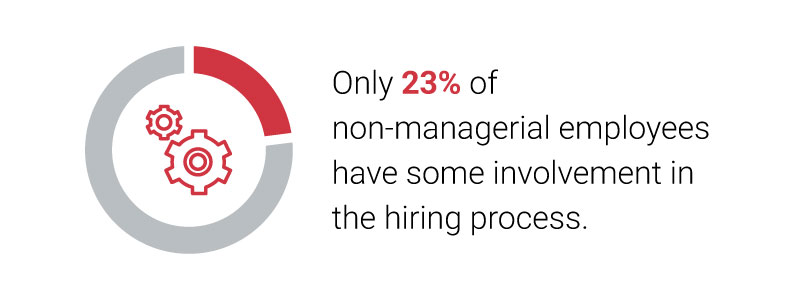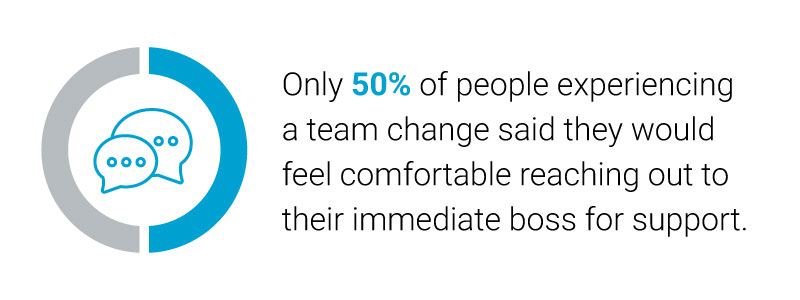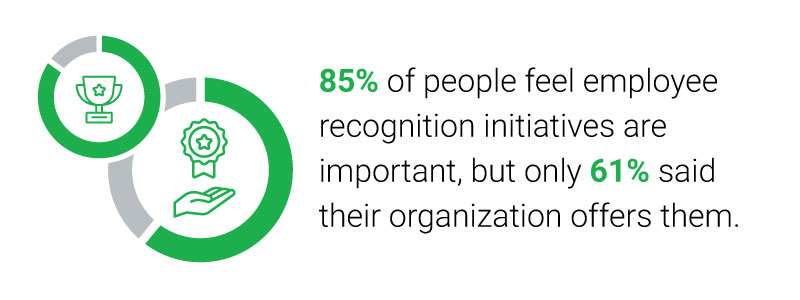Survive & Thrive in The Great Resignation: Managing Your Growing & Changing Teams
Mar 04, 2022 | 4 min read
Now, more than ever, the workplace is a temperamental ecosystem; and managers must conduct the delicate dance of overseeing ever-changing teams. With a great surge of employees leaving and entering organizations, existing teams are in a constant state of instability as relationship dynamics, workflows, and hierarchy are all under the strain of change. Managers must walk a shaky tightrope as they steward the successful transition of new workers, maintain team morale and productivity, and manage the growing workloads of remaining workers. To help, we’ve outlined a few tips for a smooth transition when handling changing teams.
Tip One: Include your employees in decision-making.

This tip may seem obvious to some, but our research indicates that only 23% of non-managerial employees have some involvement in the hiring process. We find this statistic alarming, considering the important role existing team members play in helping new employees successfully integrate into a team and the larger organization. This includes responsibilities like creating a positive and welcoming environment, teaching new team members about existing organizational and team structures, assistance in onboarding, and providing other supportive needs. These responsibilities are the foundation of the team culture that will continue long after the new employee is successfully transitioned.
From an organizational perspective, the inclusion of team members in the decision-making process has many benefits. It gives existing employees a sense of control that may have been lost when their colleague chose to leave. This ability to influence the hiring decision of a candidate shows existing employees that their opinions and views on the needs of the team are valued and important. It also gives them a sense of ownership and responsibility in ensuring the success of new employees. Whereas an employee who was not involved in hiring may see the task of supporting the transition of a new employee as a burden, an employee who helped choose a selected candidate will be more invested and motivated to ensure that the new employee is successfully onboarded and supported. In fact, 70% of individual contributors who had some involvement in the hiring process stated that their teams had high competency in transitioning new team members. Additionally, 79% of these respondents also had high confidence in their team’s ability to manage team changes in the next two years. Teams whose members are invested in the growth and development of each other will also increase the agility of their organization.
Overall, having 23% of individual contributors regularly involved in the hiring process is not enough. This discrepancy needs to be rectified as individual contributors play a crucial role in the adjustment of new employees into the workplace. Processes like the development of team expectations, criteria for hiring, interviewing of candidates, and the creation of onboarding plans can all be greatly improved by their involvement.
Tip Two: Have open and consistent conversations about stressors and options for support.
The loss and consequent addition of new team members is a stressful process that results in more work for the employees caught in the middle of this transition. 53% of our surveyed individual contributors identified an increase in workload after experiencing some sort of team change, like the loss or addition of a team member, change of manager, or moving teams. Specifically, individual contributors that experienced the loss of a team member were 1.5 times more likely to experience an increase in workload than those who have not lost a team member.

Unfortunately, the sudden increase in workload is just one of the many stressors that employees are facing as their team changes. As a new team member is integrated into an existing team, the culture of that team may undergo a period of instability and confusion. Our research indicates that an overwhelmed employee will be less likely to feel comfortable asking for help when experiencing stress at work; so, it’s important for managers to be the ones to initiate those conversations. In fact, only 50% of people experiencing a team change said they would feel comfortable reaching out to their immediate boss for support. This highlights the importance of managers and leaders checking in with their employees regularly to listen and identify stressors, redistribute the workload that was left behind, and reprioritize as needed.
Tip Three: Show appreciation to your team.

Often during this transitionary period, many employees will go above and beyond the expectations of their role in order to help carry the weight of lost team members. These contributions need to be properly recognized in order to show employees that their hard work, dedication to the organization, and commitment to their team is acknowledged and appreciated. While most people agree with that sentiment, only 61% of individual contributors stated that their organizations offered employee recognition initiatives even though over 85% of respondents felt that employee recognition is integral in positively affecting different aspects of work culture such as increasing productivity, motivation, and organizational pride.
The benefits of employee recognition are far-reaching, and our research shows it can impact everything from openness to change to a willingness to seek support. Further, we found that individual contributors whose organization currently provides employee recognition initiatives have lower overall stress ratings, are more comfortable reaching out for support, and have higher confidence in their team’s ability to manage team changes in the next two years. In a time when many employees are overworked and overwhelmed, appreciation goes a long way in helping them feel seen and valued for the work they do. This appreciation can make all the difference in employees’ sentiment towards their existing work culture and consequently their long-term commitment to their organization.
With employee turnover at an all-time high and teams changing at a rapid pace, managers must find a way to balance staffing needs with the needs of existing employees in order to smoothly navigate this change. This includes involving employees in the hiring process, monitoring stressors, providing support, and facilitating opportunities for recognition and appreciation. These small steps can make all the difference in an organization’s ability to successfully address growing and changing teams.
